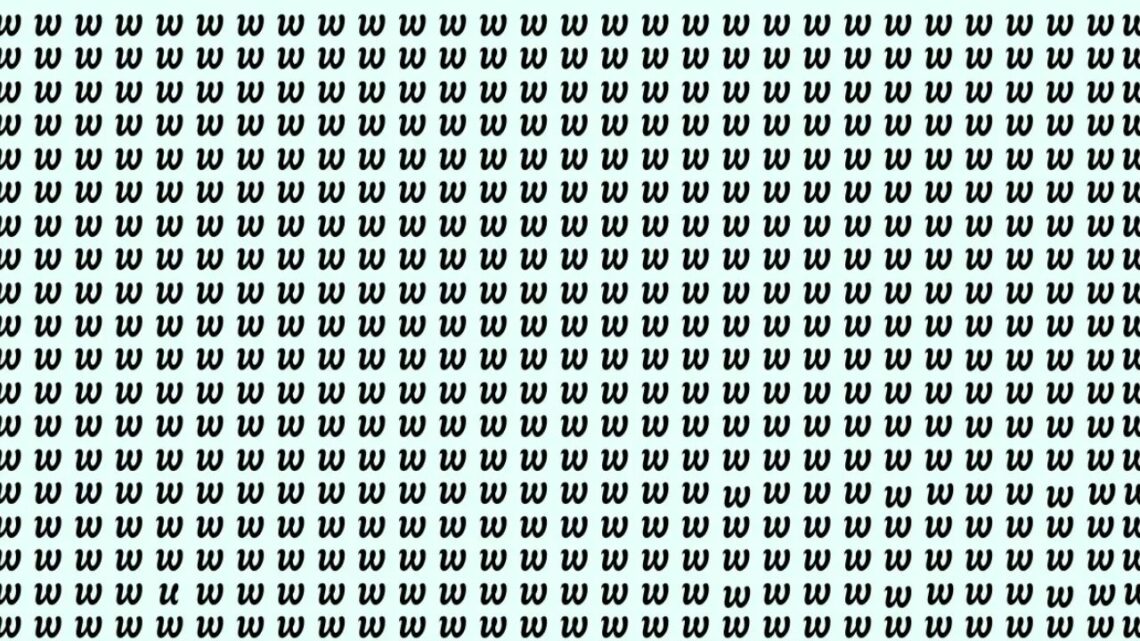Get ready for one of the internet’s most exciting optical illusion challenges — the hunt for the hidden letter “U” among a grid of nearly identical “W”s.
At first glance, this puzzle looks simple, but don’t be fooled. With dozens of letters filling the grid, your brain is tricked into overlooking the small but critical differences.
The challenge? Find the “U” within just 5 seconds. It’s a true test of your focus, observation, and visual speed.
The Challenge Explained
The puzzle works by presenting a grid full of “W”s arranged in rows and columns. Hidden somewhere in this sea of peaks and angles is a single “U”.
Both letters are very similar — vertical strokes and symmetrical spacing make the “U” blend almost seamlessly with its neighbors. The real difference lies at the bottom:
- “W” has sharp two peaks.
- “U” has a rounded base.
Under time pressure, these small differences can become incredibly hard to spot, making the challenge both entertaining and brain-boosting.
Why Optical Illusions Like This Are Popular
1. Fun & Engaging
They’re quick puzzles that can be solved on the go, making them popular across social media.
2. Mental Exercise
Illusions like these improve attention to detail, reaction time, and visual processing speed.
3. Stress Relief
Focusing on a short challenge offers a break from daily stress, giving your brain a chance to reset.
4. Shareable Content
Friends and families love to compete — “Did you spot the U in time?” becomes an instant conversation starter.
The Trick to Spotting the “U”
So, how do you succeed in this challenge? The trick lies in shifting your focus:
- Scan the bottoms of the letters. Look for the curve instead of the peaks.
- Divide the grid into sections. Break it down row by row instead of scanning the whole pattern at once.
- Train your eyes. The more you practice with these illusions, the quicker your brain gets at identifying anomalies.
By using these techniques, you’ll train your brain to spot details others might miss.
The Solution: Where Is the “U”?
If you’ve been scanning and still can’t spot it — here’s the answer. The hidden “U” is located in the second row from the bottom, about the fifth position from the left.
It’s easy to overlook, but once you know where it is, the rounded base jumps out immediately. This demonstrates how our brains process patterns before details—and why optical illusions are so fascinating.
Key Details of the Optical Illusion Challenge
| Feature | Details |
|---|---|
| Type of Puzzle | Optical illusion / hidden letter challenge |
| Letters Used | “W” (main grid), with one hidden “U” |
| Difficulty Level | Moderate to hard (due to similarity between letters) |
| Time Limit | 5 seconds recommended for the challenge |
| Trick to Solving | Look at the bottom shape — rounded curve of “U” vs. peaks of “W” |
| Solution Location | Second row from the bottom, fifth position from the left |
| Benefits | Improves focus, observation, and mental agility |
Benefits of Playing This Puzzle
- Improves Focus – You train your brain to notice subtle differences.
- Boosts Mental Speed – Quick decision-making under time pressure builds sharper thinking.
- Enhances Visual Memory – Helps you remember patterns more effectively.
- Encourages Mindfulness – Forces your attention to the present task, reducing distractions.
The “Spot the Hidden U Among W’s” challenge is more than just a fun distraction. It’s a way to test your observation skills, push your focus under pressure, and engage your mind in a quick, enjoyable workout.
Though the “U” looks almost identical to the “W”, spotting its rounded curve in time delivers a satisfying “aha!” moment.
So, did you find the hidden U within five seconds, or did it take you a little longer? Either way, this clever illusion proves just how fascinating our brains are — and why these viral puzzles never get old.
FAQs
Why is the “U” so hard to find among “W”s?
Because both letters share similar vertical lines, our brain processes them as identical patterns, making the small curve easy to miss.
How can I improve my speed at spotting illusions like this?
Practice regularly, focus on one section at a time, and train your eyes to look for shape differences instead of scanning randomly.
What are the benefits of doing optical illusion puzzles?
They help sharpen focus, boost reaction time, and reduce stress, while also being fun and engaging for all ages.
